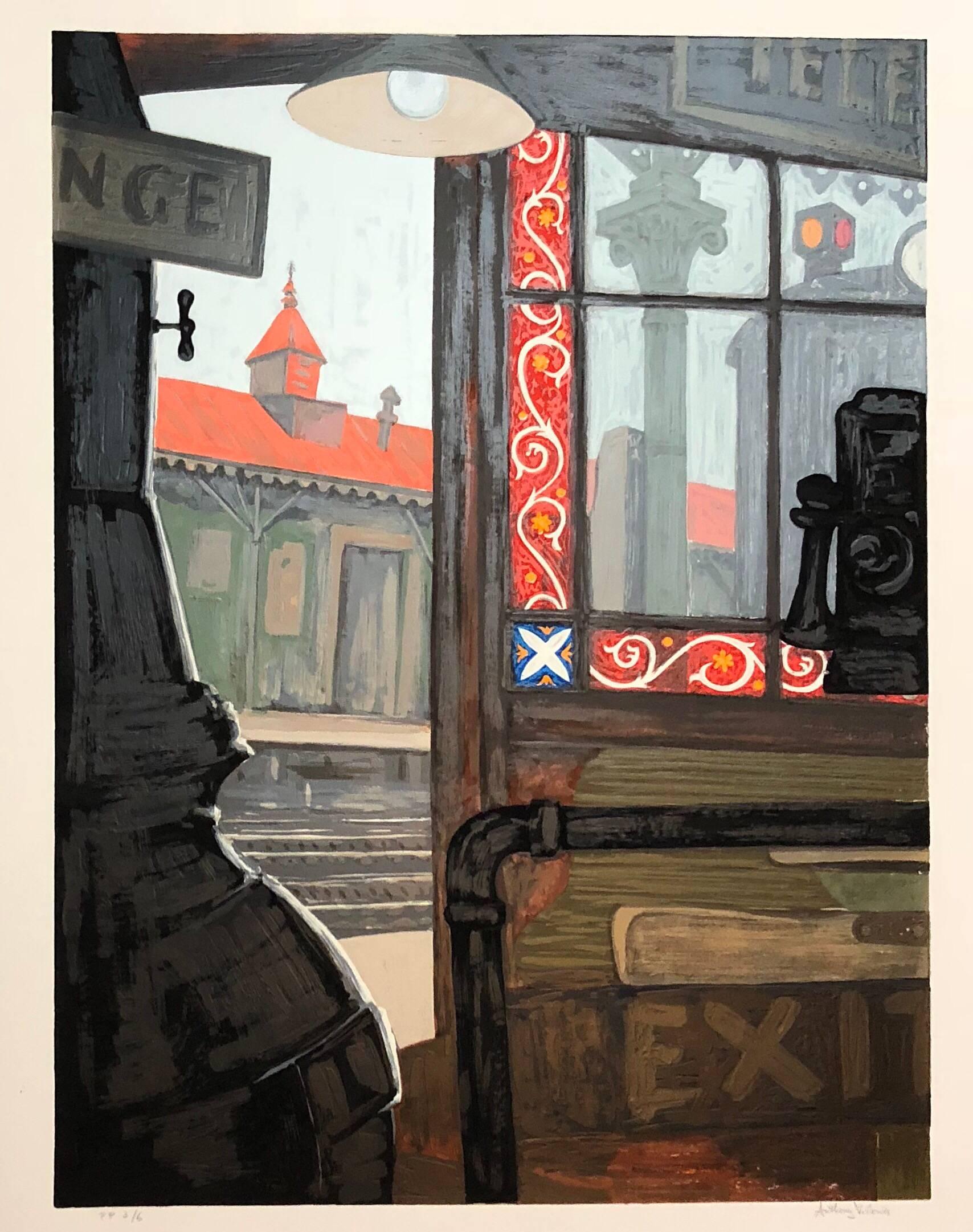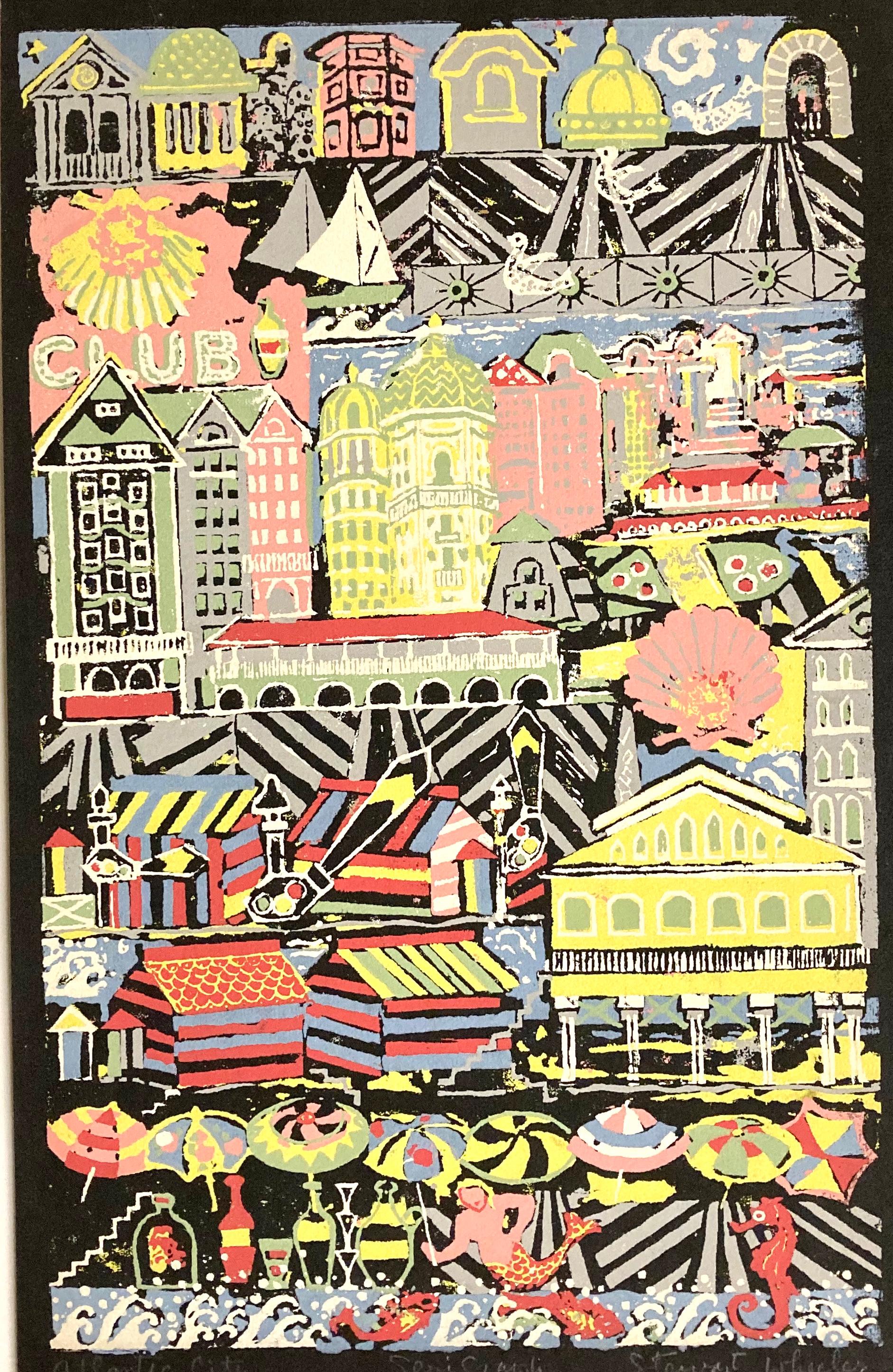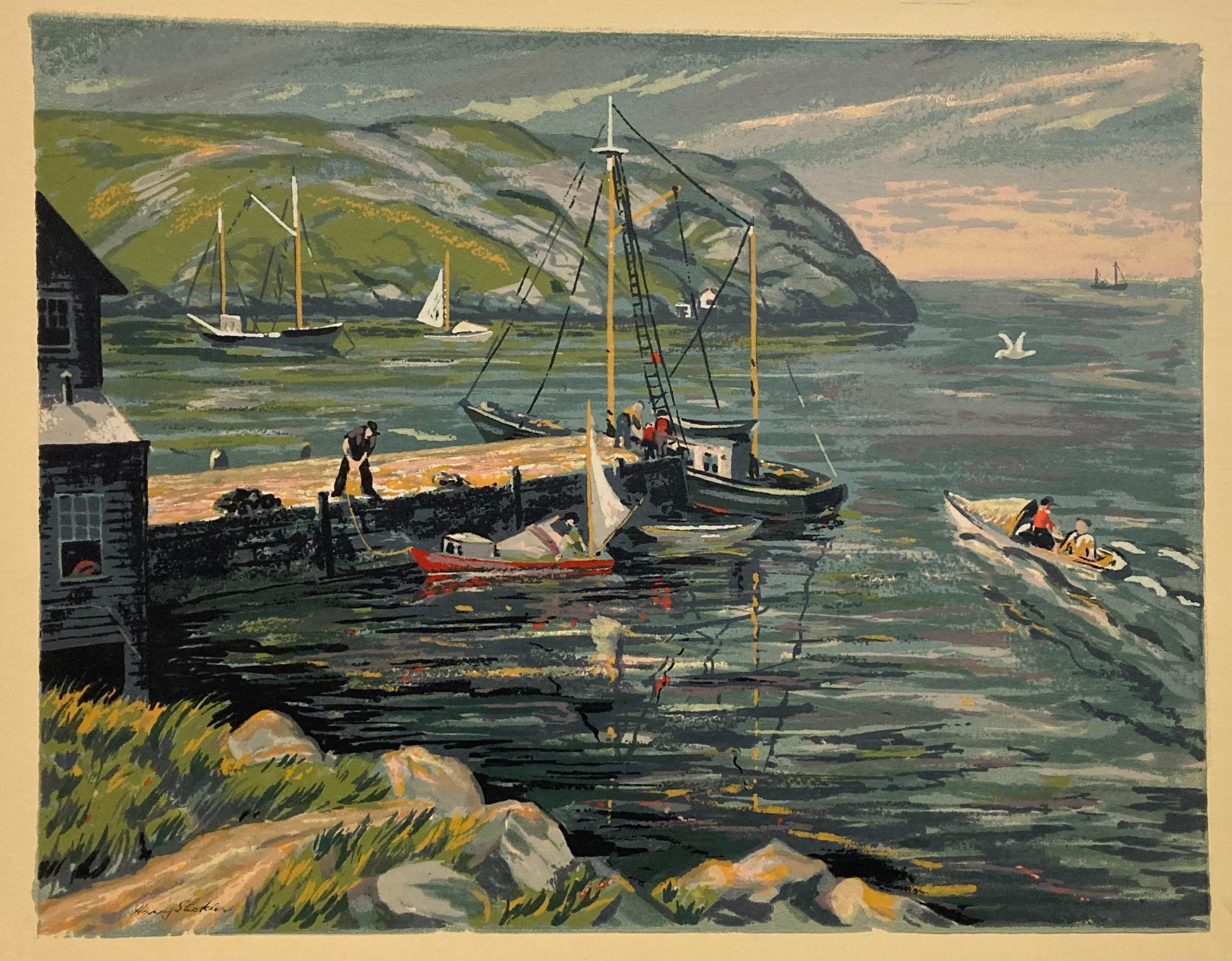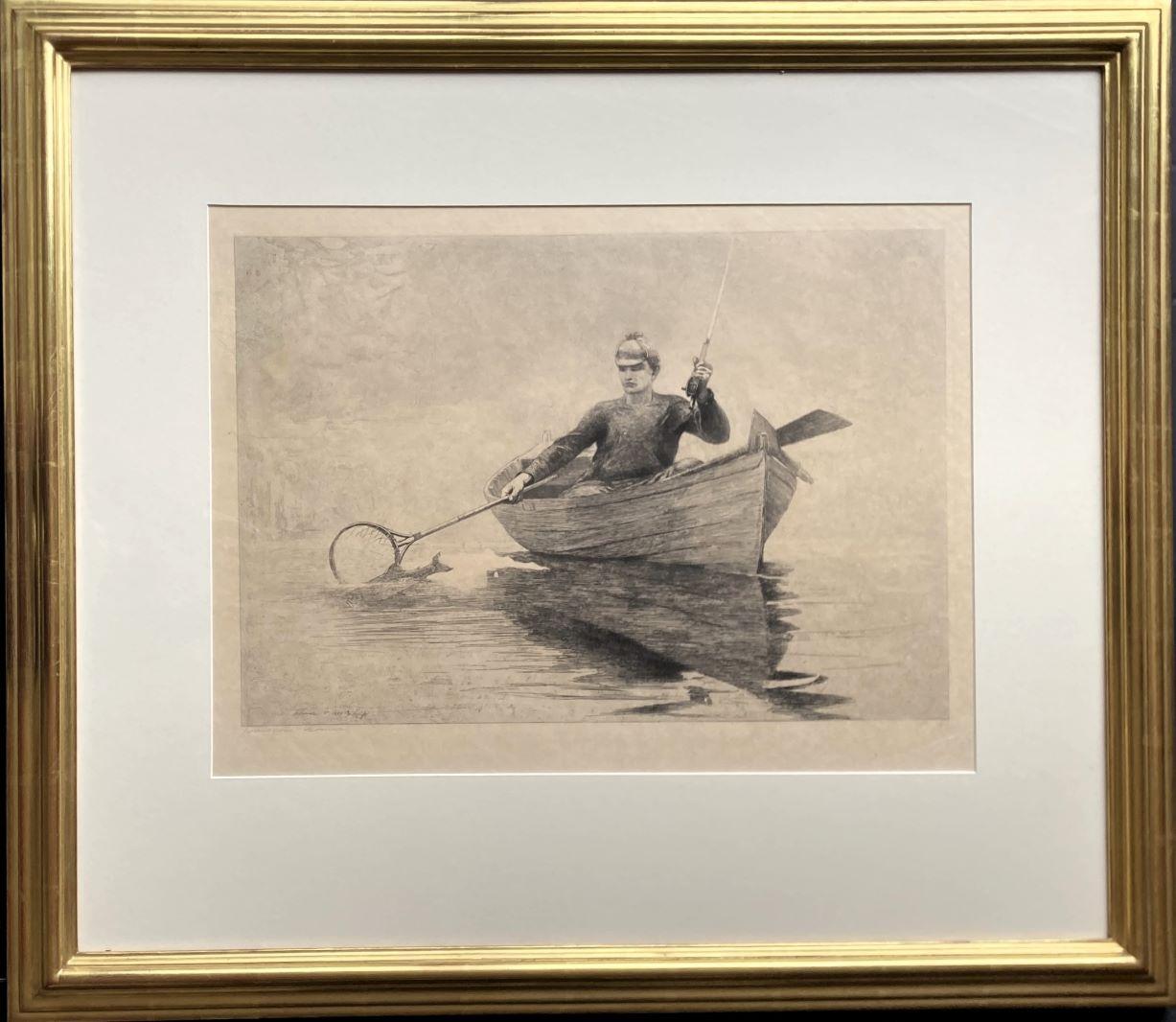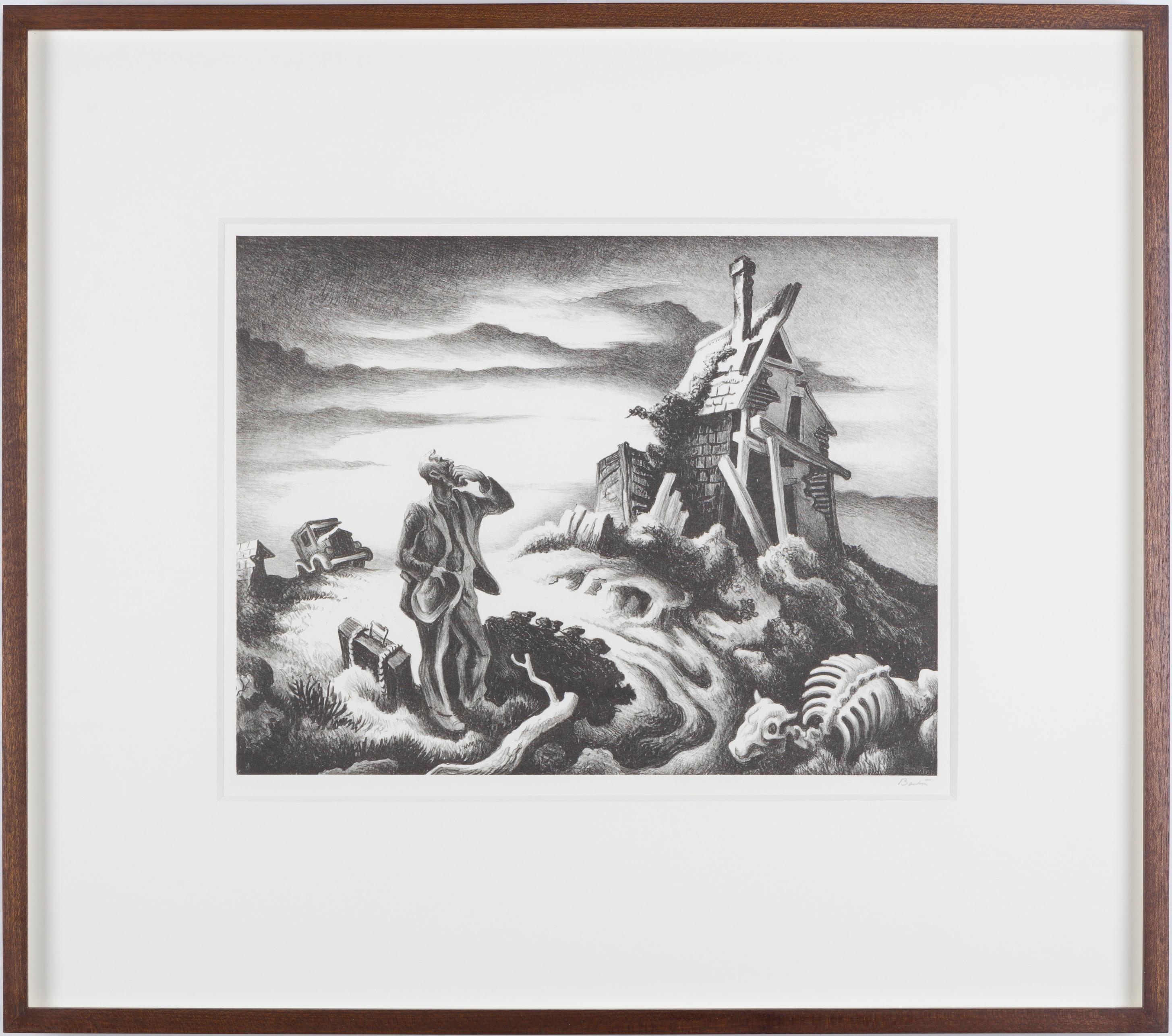Items Similar to Original "Think American" USA World War II vintage poster
Want more images or videos?
Request additional images or videos from the seller
1 of 8
Chester Raymond MillerOriginal "Think American" USA World War II vintage poster1943
1943
About the Item
Original poster: For a Country Where We Are Still Masters of Our Own Destinies, Let's Be Truly Thankful. Silk-screened patriotism. This is a poster meant to appeal to the American family. Soft, rich colors and a patriotic vision...
This poster has been archivally mounted on linen and is in fine condition condition. Touched up pin-holes in the corners. A- condition.
The Original Think American, USA World War 2 Poster is a captivating piece of history and art. This vintage poster showcases a unique design that captures the era's essence. It features a pilgrim couple gazing out to sea towards their three-master schooner, representing America's pioneering and adventurous spirit. The outline of the United States is a powerful symbol of national pride and strength. The large text along the bottom of the poster delivers a thought-provoking message, reminding viewers to be grateful for the country where they can shape their own destinies. Created and printed by Think America, a renowned brand, this poster is a true collector's item that celebrates American history and values.
The ghosted image of early Pilgrims seems to reach out to the American family who are standing on an outline of the United States. The old sailing ships are in the background. Think American.
The Think American Institute was formed by a group of industrialists from Rochester, New York, to combat subversive propaganda they felt was infiltrating American business. The group aimed to preserve the social order, boost American morale, extend the institutions of American freedom, and aid the war effort after the U.S. entry into World War II. The group was led by William G. Bromley, president of Kelly-Read & Company, and the lead designer Miller, who also served as the Art Director for Kelly-Read & Company. The Think American Series ran from 1939 to the early 1960s.
This is an Original Lithograph Vintage Poster; it is not a reproduction.
- Creator:Chester Raymond Miller (1898 - 1968, American)
- Creation Year:1943
- Dimensions:Height: 27.25 in (69.22 cm)Width: 20 in (50.8 cm)Depth: 0.05 in (1.27 mm)
- Medium:
- Movement & Style:
- Period:
- Condition:Original vintage poster in A- condition with archival linen backing, ready to frame. Certificate of Authenticity with an embedded image of the poster. Rarely, if ever, available original Think American series World War 2 vintage posters.
- Gallery Location:Spokane, WA
- Reference Number:
About the Seller
5.0
Platinum Seller
These expertly vetted sellers are 1stDibs' most experienced sellers and are rated highest by our customers.
Established in 1998
1stDibs seller since 2020
156 sales on 1stDibs
Typical response time: 1 hour
- ShippingRetrieving quote...Ships From: Spokane, WA
- Return PolicyA return for this item may be initiated within 3 days of delivery.
More From This SellerView All
- Original "Wagon Lits" pop art style serigraph travel by train posterBy Valerio AdamiLocated in Spokane, WAOriginal “Wagon Lits” serigraph poster by the artist Valerio Adami. It was printed in France by GrafiCaza (Michel Caza), one of the finest serigraph companies on woven paper—in exce...Category
1990s American Modern Figurative Prints
MaterialsScreen
- Original 'We're both needed to serve the Guns!" vintage British poster, 1915Located in Spokane, WAOriginal poster: FILL UP THE RANKS PILE UP THE MUNITIONS! Artist: F. Gardner. Year: 1915. Horizontal original British WW1 poster. Very good cond...Category
1910s American Modern Landscape Prints
MaterialsLithograph
- Original "Back Them Up!" vintage British WWII posterLocated in Spokane, WAOriginal WWII poster: A British "Commando" raid on a German-held port in Norway. Back Them Up! Linen backed and ready to frame. Printed in England...Category
1940s American Modern Landscape Prints
MaterialsLithograph
- Original "Children's Year" vintage poster. The health of the child is the powerLocated in Spokane, WAOriginal "Children's Year" Health of the Child is Power of the Nation vintage poster. Archival linen backed original 1919 horizontal. Lathrop, the Children's Bureau's first director, soon commissioned several studies to investigate the causes and conditions of infant mortality. She wanted hard data to dispel the notions that child death was inevitable or an act of God, and to prove that infant mortality was not about genetics but rather environment. Lathrop's research showed that children often died from infections and conditions that could be prevented. To spread the facts, the Bureau published a series of advice pamphlets on infant care. Children's Bureau under Lathrop created a powerful, lasting legacy in the U.S. — the idea that every child has a right to a childhood. "That every kid has a right to dependency," she says. "That they don't have to support themselves, and that the government is the parent of last resort if everything else fails." Rare horizontal poster...Category
1910s American Modern Landscape Prints
MaterialsLithograph
- Original Lake Tahoe Reno Las Vegas Holiday for Two vintage posterLocated in Spokane, WAOriginal LAKE TAHOE, RENO, LAS VEGAS - Get your HOLIDAY FOR TWO here vintage travel poster. Archival linen backed in very fine condition, ready to frame. This is a fun vintage travel poster from c. 1970’s that highlights the fun and interesting places and attractions to see and visit in Nevada. Many of the casinos shown in the poster have been replaced with newer and larger venues. A great game...Category
Late 20th Century American Modern Landscape Prints
MaterialsOffset
- Original "Ali Flotte Riunite, Italian Air Services" vintage airlines poster.Located in Spokane, WAOriginal Italian Air Service Lines Aeriennes Italiennes Original travel poster; linen backed. Printed in Italy. Printed: 1951. Artist: F. Romoli. Ali Airlines Operated from ...Category
1950s American Modern Figurative Prints
MaterialsOffset
You May Also Like
- Modernist Silkscreen Screenprint 'El Station, Interior' NYC Subway, WPA ArtistBy Anthony VelonisLocated in Surfside, FLscreenprint printed in color ink on wove paper. New York City subway station interior. Anthony Velonis (1911 – 1997) was an American painter and designer born in New York City who helped introduce the public to silkscreen printing in the early 20th century. While employed under the federal Works Progress Administration, WPA during the Great Depression, Velonis brought the use of silkscreen printing as a fine art form, referred to as the "serigraph," into the mainstream. By his own request, he was not publicly credited for coining the term. He experimented and mastered techniques to print on a wide variety of materials, such as glass, plastics, and metal, thereby expanding the field. In the mid to late 20th century, the silkscreen technique became popular among other artists such as Robert Rauschenberg and Andy Warhol. Velonis was born into a relatively poor background of a Greek immigrant family and grew up in the tenements of New York City. Early on, he took creative inspiration from figures in his life such as his grandfather, an immigrant from the mountains in Greece, who was "an ecclesiastical painter, on Byzantine style." Velonis attended James Monroe High School in The Bronx, where he took on minor artistic roles such as the illustration of his high school yearbook. He eventually received a scholarship to the NYU College of Fine Arts, into which he was both surprised and ecstatic to have been admitted. Around this time he took to painting, watercolor, and sculpture, as well as various other art forms, hoping to find a niche that fit. He attended NYU until 1929, when the Great Depression started in the United States after the stock market crash. Around the year 1932, Velonis became interested in silk screen, together with fellow artist Fritz Brosius, and decided to investigate the practice. Working in his brother's sign shop, Velonis was able to master the silkscreen process. He reminisced in an interview three decades later that doing so was "plenty of fun," and that a lot of technology can be discovered through hard work, more so if it is worked on "little by little." Velonis was hired by Mayor LaGuardia in 1934 to promote the work of New York's city government via posters publicizing city projects. One such project required him to go on a commercial fishing trip to locations including New Bedford and Nantucket for a fortnight, where he primarily took photographs and notes, and made sketches. Afterward, for a period of roughly six months, he was occupied with creating paintings from these records. During this trip, Velonis developed true respect and affinity for the fishermen with whom he traveled, "the relatively uneducated person," in his words. Following this, Velonis began work with the Public Works of Art Project (PWAP), an offshoot of the Civil Works Administration (CWA), where he was assigned to serve the different city departments of New York. After the formation of the federal Works Progress Administration, which hired artists and sponsored projects in the arts, he also worked in theater. Velonis began working for the federal WPA in 1935. He kept this position until 1936 or 1938, at which point he began working in the graphic art division of the Federal Art Project, which he ultimately led. Under various elements of the WPA program, many young artists, writers and actors gained employment that helped them survive during the Depression, as well as contributing works that created an artistic legacy for the country. When interviewed in December 1994 by the Library of Congress about his time in the WPA, Velonis reflected that he had greatly enjoyed that period, saying that he liked the "excitement" and "meeting all the other artists with different points of view." He also said in a later interview that "the contact and the dialogue with all those artists and the work that took place was just invaluable." Among the young artists he hired was Edmond Casarella, who later developed an innovative technique using layered cardboard for woodcuts. Velonis introduced silkscreen printing to the Poster Division of the WPA. As he recalled in a 1965 interview: "I suggested that the Poster division would be a lot more productive and useful if they had an auxiliary screen printing project that worked along with them. And apparently this was very favorably received..." As a member of the Federal Art Project, a subdivision of the WPA, Velonis later approached the Public Use of Arts Committee (PUAC) for help in "propagandizing for art in the parks, in the subways, et cetera." Since the Federal Art Project could not be "self-promoting," an outside organization was required to advertise their art more extensively. During his employment with the Federal Art Project, Velonis created nine silkscreen posters for the federal government. Around 1937-1939 Velonis wrote a pamphlet titled "Technical Problems of the Artist: Technique of the Silkscreen Process," which was distributed to art centers run by the WPA around the country. It was considered very influential in encouraging artists to try this relatively inexpensive technique and stimulated printmaking across the country. In 1939, Velonis founded the Creative Printmakers Group, along with three others, including Hyman Warsager. They printed both their own works and those of other artists in their facility. This was considered the most important silkscreen shop of the period. The next year, Velonis founded the National Serigraph Society. It started out with relatively small commercial projects, such as "rather fancy" Christmas cards that were sold to many of the upscale Fifth Avenue shops...Category
1980s American Modern Figurative Prints
MaterialsScreen
- Stewart Wheeler, Atlantic City (New Jersey)Located in New York, NYThe little that is know about the painter and printmaker Stewart Wheeler indicates that most of his career was spent in Philadelphia, Pennsylvania. And...Category
Mid-20th Century American Modern Landscape Prints
MaterialsScreen
- Harry Shokler, Island HarborBy Harry ShoklerLocated in New York, NYHarry Shokler used serigraphy to great advantage in this landscape. It's colorful and detailed. It is signed in the image at the lower left. When printmakers began making serigraphs...Category
1940s American Modern Figurative Prints
MaterialsScreen
- Fly Fishing, Saranac LakeBy Winslow HomerLocated in Storrs, CTFly Fishing, Saranac Lake. 1889. Etching, aquatint and burnishing. Goodrich 104. 14 1/4 x 20 5/8; sheet 18 1/2 x 24 1/2. Edition unknown but quite possibly intended 100; highest numb...Category
Late 19th Century American Modern Figurative Prints
MaterialsEtching
- Prodigal SonBy Thomas Hart BentonLocated in London, GBA fine impression with full margins published by Associated American Artists with their information label present - pictured in Art and Popular Religion in Evangelical America, 1815-...Category
1930s American Modern Landscape Prints
MaterialsLithograph
- Into the Night (a lone male emerges from a subway stop by the Flatiron Building)By Frederick MershimerLocated in New Orleans, LAA lone figure emerges out of bright lights streaming from a subway entrance at the corner of 23rd and Broadway near the Flatiron Building and Madison Square Park. He has just exited the uptown...Category
Early 2000s American Modern Figurative Prints
MaterialsMezzotint
